Toshiba is not a brand we see too much of in the busy HDTV market, so we were delighted when the Japanese firm sent a sample of its 47VL863B 3D LED LCD TV to us for review. The 47VL863B sits very near the top of Toshiba’s lineup this year, but its most unique feature is probably the fact that it uses the passive 3D system (the benefits of which are ultra-cheap, lightweight and flicker-free 3D glasses) rather than the more common active-shutter system.
Aside from extra-dimensional fun, the 47VL863B features some extra calibration controls that we’ve not seen on a Toshiba display before. In fact, it can actually calibrate itself if a compatible calibration device (Toshiba recommends the i1 Display Pro) is plugged in to its USB socket, which is great news. There are also tuners for Digital Terrestrial HDTV (Freeview HD) and for satellite, although UK readers should note that the Toshiba 47VL863B doesn’t feature the Freesat branding, so you’ll need to do without the Freesat on-screen programme guide.
This all seems mighty tempting, especially for a 3D TV with a price tag under four figures, so let’s see what’s in store…
Note: The model we reviewed is the Toshiba 47VL863B, which is the 3-pin-plug British version. While we did not test the 42-inch Toshiba 42VL863B, there should not be any major difference in picture performance given similar specifications within the VL863 series.
Jump To: Operation • Calibration • Picture Performance • Conclusion
Design
The Toshiba 47VL863B is well styled, with a fairly non-reflective LCD panel, and also a matte grey bezel. This is a fantastic move on Toshiba’s part, because glossy black plastic (which we’ve honestly never liked anyway, if only due to its scratch-prone nature) can reflect ambient light, creating an obvious border around the 3D image and preventing true immersion. There is still a glossy black strip at the bottom of the VL863, though, which has some touch sensitive zones on it. Since these were located on the glossy area, we could never actually bring ourselves to touch them and spoil the 47VL863’s aesthetics with our greasy fingerprints.
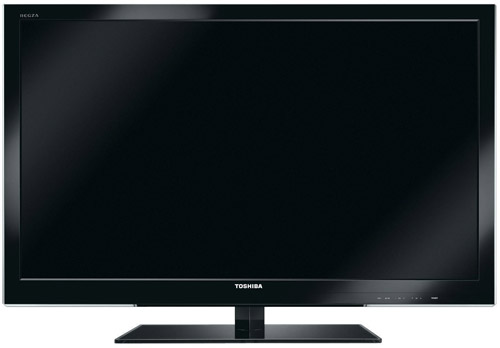
The remote control is equally interesting, being a change from Toshiba’s past units. It’s curved and made of matte black plastic, and curiously has a silver metal cover in the middle, which slides up and down. This can either slide into the middle of the remote to cover some less used buttons, or down to the bottom to reveal everything. Although we appreciate the design sentiment, we would actually have appreciated a way to take this off, since it feels like it’s getting in the way. Not only that, but since it’s made of light metal, it can actually get quite cold!
Toshiba supplies the 47VL863B with no less than five pairs of passive RealD 3D glasses, but if you have an especially large family, you can even bring back passive 3D glasses from the cinema and use these.
Connections
The Toshiba 47VL863B features the now-standard 4 HDMI inputs, and provision for SCART and Component analogue interfaces, via included break-out adapter cables. There’s also an RGB (“VGA”) PC input, 2 USB sockets, feeds for the terrestrial/cable and satellite tuners, and audio outputs. There’s also an ethernet/LAN socket for connecting the TV to a home network.
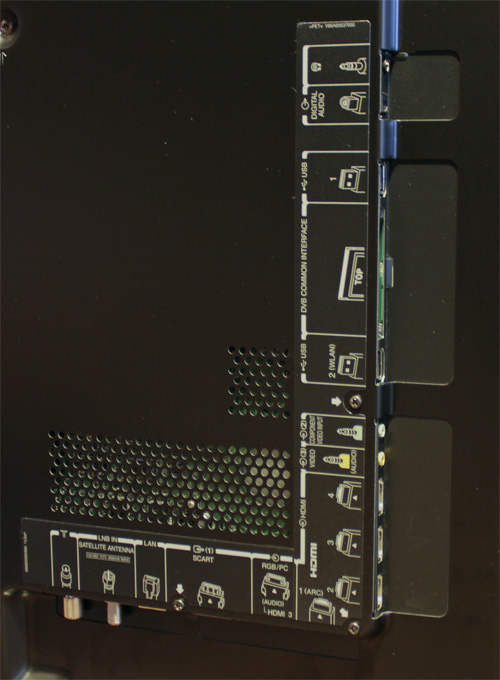 |
| Rear: 4 x HDMI, VGA, Component, SCART, aerial, satellite, ethernet & audio outs |
Operation
The 47VL863 features a new front end for Toshiba’s fairly likeable, legible, easy-to-use on screen menus. Pressing the MENU button on the remote brings up a selection of icons which are arranged in a semi-circle arrangement; selecting one of these categories brings up more icons, which in turn lead to the more familiar and traditionally arranged menus.
Of most interest to us are the picture setup controls, which we’ll use to squeeze every last drop of quality out of the Toshiba 47VL863B (we’ll of course share any quality improving tips for owners along the way). The top adjustment is [Picture Mode], which comes set to “AutoView”. This out-of-the-box preset mode presents a dull, blue-tinted picture, which has clearly been designed with power saving in mind. There are also “Standard” and “Dynamic” modes, as well as “Hollywood Day”, “Hollywood Night”, and “Hollywood Pro”. We used the “Pro” mode, since it unlocks all of the 47VL863B’s picture setup controls.
![[Picture] menu](/news/wp-content/uploads/2018/04/hdtv_Toshiba-47VL863B_pic1.jpg) |
|
| [Picture] menu | |
Control is given over all of the standard picture setup parameters, as you’d expect, but it’s in the two Advanced menus where things begin to get interesting. First of all, there’s [ColourMaster], which has appeared on Toshiba TVs for some time now (although not always under this name), and has never worked entirely correctly from our calibrators’ perspective. Here, the Hue, Saturation and Brightness of all six colours can be adjusted; however, the “Brightness” adjustment is unusable, because it brings out severe amounts of noise in the image. Interestingly, the Toshiba 47VL863 has another colour calibration menu, this time called… “Colour Calibration”. We’ll get to the bottom of all this later when we calibrate the 47VL863B for the best possible image quality.
Moving down the list, there’s a potentially contrast-enhancing “LED Backlight Control”, which adjusts the intensity of the LED lighting to correspond with the brightness of the picture content, in an attempt to increase contrast performance and gain deeper blacks. There are also “Noise Reduction” controls, Toshiba’s “Resolution+” edge sharpening system, and some control over the “Active Vision M400” motion clarity enhancing system.
![[Colour Calibration] menu](/news/wp-content/uploads/2018/04/hdtv_Toshiba-47VL863B_colourcal.jpg) |
|
| [Colour Calibration] menu | |
Stepping back out of this menu and into “Expert Picture Settings”, we have access to a built-in test pattern, the ability to turn either the Red, Green or Blue RGB components off (useful for fine-tuning colour settings by eye – but we don’t need to do this since we’re using a dedicated calibration instrument), a selection for either SD or HD “Colour Decoding” levels (just in case you have an upscaling DVD player which is outputting the wrong ones), a 10-point White Balance control, the aforementioned “Colour Calibration” screen, and lastly, “Gamma Calibration”.
Still with us? Don’t worry – we’ll be explaining which of these settings are useful and which ones to avoid during the “Calibration” section of the review.
2D Calibration
Note: Our Toshiba 47VL863B review sample was calibrated using Calman Professional, the industry-leading video calibration software.
The 47VL863B defaults to the “AutoView” setting for each picture input, so we made sure to change this to “Hollywood Pro” before we began altering the picture settings. We then measured the following data from the Toshiba 47VL863B:
2D Mode Greyscale
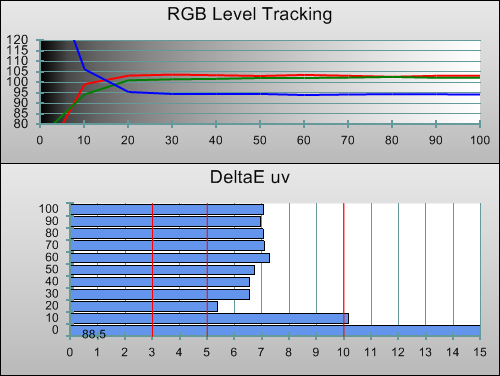 |
| Pre-calibration RGB tracking and delta errors (dEs) |
We had already detected an over-warm, “summery haze” tinge to the Toshiba 47VL863B’s pictures, which was explained by the green-red tint and lack of blue making up Grey shades in the image. Normally, we’re used to seeing TVs with an excess of blue, and being spoiled for choice when it comes to watching perfectly accurate, calibrated screens, we’re not in a position to really say which error is worse. It probably won’t be too noticeable for the majority of users.
![Post-calibration RGB Tracking in [Hollywood Pro] mode](/news/wp-content/uploads/2018/04/hdtv_Toshiba-47VL863B_post-rgb.png) |
| Post-calibration RGB tracking and dEs in [Hollywood Pro] mode |
Unfortunately, we don’t have the exact calibration meter which Toshiba requires to make use of the automatic calibration features, so we adjusted the [White Balance] controls the old fashioned way (we did try connecting both our Klein K-10 and DTP94 meters to the TV, but it didn’t know how to communicate with either of these, unsurprisingly). Greyscale perfection was possible with the 10-point control in the menu, which acts much the same as it does on any other manufacturer’s TV. Using this menu, we reduced the amount of red and green in the picture where necessary, and also made more specific corrections for the darker areas of the picture (which actually had too much blue before calibration). We double-checked Gradient test patterns after the calibration, and were glad to see that no additional spurious colour tints were appearing at any shades inbetween the 10% intervals we made adjustments at.
![Gamma curve in [Hollywood Pro] mode](/news/wp-content/uploads/2018/04/hdtv_Toshiba-47VL863B_post-gamma.png) |
|
| Gamma curve in [Hollywood Pro] mode | Corresponding gamma tracking |
Our first calibration attempt resulted in perfect Greyscale, but with skewed Gamma tracking: or in plain English, the amount of brightness in what should have been the brighter areas of the image was not correct. This is because we had reduced the Red and Green controls, rather than leaving them locked in place and increasing the Blue control. Once we followed the latter calibration strategy, we were left with perfect Greyscale tracking (tint-free Greys) and highly accurate Gamma (correct brightness distribution).
2D Mode Colour
Unlike the advanced Gamma calibration, the TV’s “Colour Calibration” mode can be used manually, although even this is done in a new and interesting way. When we calibrate colour on HDTVs, we’re used to having access to Saturation, Hue and Luminance controls for each colour, and we display the appropriate colour on screen and adjust the TV controls until our calibration software, CalMan, shows us that we have the specific colour at its most accurate point.
The “Colour Calibration” screen instead asks the calibrator to measure the colour from the TV’s screen as usual, but then to key in the X and Y coordinates reported by the measuring software, so that the television can perform the necessary correction itself. It’s a novel approach, but it didn’t always work as intended. For example, when the TV displays the colour to be measured, it disregards the Backlight brightness setting, and since it’s an in-TV pattern, it doesn’t take into account any other potential shifts being caused by other devices in the chain.
If this “Colour Calibration” control is enabled, access to the old “ColourMaster” system is denied. We tried both methods, and found that we had better results using “ColourMaster” – although this might have been different if we’d had one of Toshiba’s officially recommended calibration meters, and could have made use of the auto calibration feature. We should point out that both methods we tried brought suitably accurate results which wouldn’t really displease many users. This is our final result from the Toshiba 47VL863B:
![Post-calibration CIE chart in [Hollywood Pro] mode](/news/wp-content/uploads/2018/04/hdtv_Toshiba-47VL863B_post-cie.jpg) |
| Post-calibration CIE chart with reference to HD Rec.709 |
![Post-calibration Luminance levels in [Hollywood Pro] mode](/news/wp-content/uploads/2018/04/hdtv_Toshiba-47VL863B_post-colour-lum.png) |
| Post-calibration colour luminance (coloured bars = targets; black bars = measured values) |
3D Calibration
This is the first Passive 3DTV to go through the full HDTVTest 3D calibration process, and one of the first things that we remarked upon was how effortless it was to tape the 3D glasses to the front of our Klein K-10 calibration meter, due to their light weight. Although this is a small benefit for calibration, it’s also a nice reminder of how comfortable the glasses are to wear on your own head!
We discovered that, like many 3D TVs on the market, the Toshiba 47VL863B hasn’t really been designed with 3D calibration in mind. When we switched into 3D mode, we saw that the same White Balance settings that we’d calibrated for use with 2D were present (in other words, there were not discrete 2D/3D memories). As a result, we switched out of the “Hollywood Pro” mode and into the neighbouring “Hollywood Day” mode, so we could optimise the 3D mode separately. Unfortunately, this meant that we had to manually switch between the two modes upon beginning and ending 3D viewing.
3D Mode Greyscale
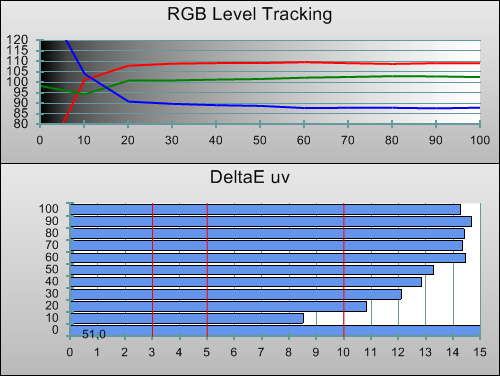 |
| 3D Pre-calibration RGB tracking and delta errors (dEs) |
Prior to calibration, there was a consistent excess of red in the 3D image, much the same as in 2D, although exaggerated slightly due to the fact that the glasses we used also brought a slight red tint of their own. The good news is that the same 10-point White Balance control is available when the Toshiba 47VL863B is in 3D mode, so we had absolutely no trouble achieving perfect Greyscale tracking for extra-dimensional content, as well. We should point out, however, that if the viewer leans their head to one side, the colour temperature of the image will begin to shift slightly (although not by much).
![3D Post-calibration RGB Tracking in [Hollywood Pro] mode](/news/wp-content/uploads/2018/04/hdtv_Toshiba-47VL863B_3d-post-rgb.png) |
| 3D Post-calibration RGB tracking and dEs in [Hollywood Pro] mode |
3D Mode Colour
![3D Post-calibration CIE chart in [Hollywood Pro] mode](/news/wp-content/uploads/2018/04/hdtv_Toshiba-47VL863B_3d-post-cie.jpg) |
| 3D Post-calibration CIE chart with reference to HD Rec.709 |
![3D Post-calibration Luminance levels in [Hollywood Pro] mode](/news/wp-content/uploads/2018/04/hdtv_Toshiba-47VL863B_3d-post-colour-lum.png) |
| 3D Post-calibration colour luminance (coloured bars = targets; black bars = measured values) |
Colour presentation in 3D mode was much the same as in 2D: never perfect, but very good for an out-of-the-box preset, and better still after calibration. Not having access to a proper Luminance control for each colour didn’t really hurt the 47VL863B’s performance, since we found that the “Saturation” adjustment in the [ColourMaster] menu controlled this fairly effectively.
Benchmark Test Results
| Dead pixels | None |
| Screen uniformity | Middle slightly brighter than edges |
| Overscanning on HDMI | 0% with [Picture Size]: “Native” |
| Blacker than black | Passed |
| Calibrated black level (black screen) | 0.14 cd/m2 |
| Calibrated black level (ANSI checkerboard) | 0.14 cd/m2 |
| Black level retention | Stable |
| Primary chromaticity | Excellent |
| Scaling | Very Good |
| Video mode deinterlacing | Very Good, only minor jaggies |
| Film mode deinterlacing | Failed 2-2 PAL film mode test |
| Viewing angle | Good for an LCD; slight darkening |
| Motion resolution | 600 |
| Digital noise reduction | Optional |
| Sharpness | Defeatable edge enhancement |
| Luma/Chroma bandwidth (2D Blu-ray) | Full Luma, vertically blurred chroma except in “Game” and “PC” modes |
| 1080p/24 capability | No judder in 2D, small judder in 3D |
| Input lag | 16ms compared to lag-free CRT |
| Full 4:4:4 reproduction (PC) | Yes, in “PC” mode |
Power Consumption
| Default [AutoView] mode (2D) | 63 watts |
| Default [AutoView] mode (3D) | 64 watts |
| Calibrated [Hollywood Pro] mode (2D) | 79 watts |
| Calibrated [Hollywood Day] mode (3D) | 93 watts |
| Standby | 1 watt |
Measurements taken with full 50% grey screen.
Picture Performance
Black Level
Black level is certainly not one of the Toshiba 47VL863B’s strong points. Before we actually measured it, we did feel that the contrast performance of this LCD panel left images slightly lacking in punch and depth, causing colours to appear perceptibly less vibrant. There is an [LED Backlight Control] option with various different settings, which raises or lowers the intensity of the LED sidelighting to correspond with the brightness of the scene being viewed. This does partly address our complaint about the blacks lacking punch, but just remember that because this reduces the overall brightness of the entire image, it’ll make shadow details harder to see – kiss goodbye to the perfectly accurate Gamma tracking we showed in the charts earlier. It also won’t do much to help scenes with a mix of dark and bright elements.
As for the hard data: when we had the [Backlight] brightness configured so that a full white patch measured at around 120 cd/m2 (that’s bright enough for most living rooms), the darkest black the Toshiba 47VL863B could muster measured at 0.14 cd/m2, which is some way away from the best we’ve seen on an LCD display (Samsung’s similarly priced displays manage around 0.04 cd/m2, which looks considerably closer to pure black). The Toshiba VL863 has its own strengths, but contrast performance isn’t one of them.
Motion Resolution
With the [Active Vision M400] setting enabled, the Toshiba 47VL863B managed to resolve around 600 lines in the FPD Benchmark Software disc’s scrolling resolution test chart. To achieve this performance, we had to set the [Motion Detection Range] setting to “Wide”. Fortunately, this did not introduce the “soap opera effect” into films as many LCD motion processing systems do, although we did occasionally notice some flickering and other motion processing glitches in this mode. In the end, we decided to leave the setting on “Wide” for TV and video material, but use the “Standard” setting for the HDMI input which our Blu-ray player was connected to, since almost everything on the BD format is 24fps film material.
3D Material
Neither the passive or active 3D systems in use in the home are without their problems. As we mentioned previously, the Toshiba 47VL863B uses the passive system. LG, who are quite vocal in discussing the benefits of passive 3D, have cleverly named it “Cinema 3D”, to stress the fact that like the 3D systems installed in multiplex cinemas, home passive 3D TVs also exploit polarised light in order to present a 3D effect to the viewer’s brain. It’s not too bad a comparison: just like these cinema systems, the home passive system uses 3D glasses which are lightweight, cheap, and are not battery powered, so never need to be recharged. The biggest benefit that we found, though, was that watching 3D images on the Toshiba 47VL863B was very, very comfortable over a long period of time, thanks to the passive system’s lack of flicker.
Of course, one thing doesn’t compare to the 3D cinema experience – like with so many things in the AV world, something has to give, and that something happens to be resolution. Passive 3D TVs do not present a true High Definition picture when they are operating in 3D mode, because half of the lines on the screen are directed to the left eye, and half to the right. Half of 1080 is 540, which actually leaves 3D images viewed on a passive display with slightly less vertical resolution than our European PAL standard def TV images – although for a number of reasons which are outwith the scope of this review, users shouldn’t expect their 3D Blu-ray Discs to look as bad as standard def PAL (if you’d like to know why, ask us in the Comments).
It’s not the lessened resolution which is the most notable side-effect of the passive 3D image, though. When viewing a passive 3D TV such as the Toshiba 47VL863B with the 3D glasses on, you’ll notice that the image has a “scan-line” like pattern over it: every second line in the picture is black, due to the fact that alternate lines are being sent to alternate eyes. This is certainly not cinema-like. Interestingly, having these sharp lines overlaid on the picture actually causes it to appear perceptibly sharper, which does superficially compensate for the resolution loss to some extent. Some users claim that they simply don’t notice the lines from their normal viewing distance, and this will likely be user dependent. We could certainly still pick the lines out from the other side of the room, although even whilst doing so, we appreciated the passive 3D system’s many other strengths.
The choice of active versus passive is down to individual preference. Users will have to decide what’s more important, taking their own eyesight and viewing conditions into mind, and which set of strengths they’d rather adopt: the ultra-cheap, lightweight, flicker-free glasses afforded by the passive system, or the full (or nearly full, in most cases) 1080 lines of picture resolution and lack of any dark lines given by the active method.
With that out of the way, how does the 47VL863B perform with motion in 3D? We noticed that the [Active Vision M400] setting is disabled when this TV is in 3D mode, and when we played a Blu-ray 3D disc (24fps), we did notice some subtle judder that wasn’t present when the TV output the same material in 2D. However, we felt that it was fairly subtle and won’t be troubling to too many users. On the flip-side, we were delighted to see that the 47VL863B reproduced 50hz 3D content without any judder or stutter, great news for prospective buyers who want a display to watch Sky’s 3D services (which are 50hz).
We were happy with the pre-calibrated 3D picture quality, and were glad to see that it didn’t display any of the huge Greyscale tracking errors that early active 3D Plasma displays exhibited. The pre-calibrated 3D picture on this HDTV did feature a slight red haze, but this was hardly any worse than most out-of-the-box 2D images we see. In terms of colour, we could hardly be happier with the tint-free images produced after calibration using the Toshiba 47VL863B’s extensive setup menus. During subjective viewing of 3D content, we were impressed at how little crosstalk was visible, using discs such as Despicable Me, Cloudy With A Chance of Meatballs, and some manufacturer-specific demo discs. We did turn the [Sharpness] control up a little to artificially compensate for the passive 3D system’s lessened resolution.
Overall, we were very impressed with the many benefits that the passive 3D system brings to the Toshiba 47VL863B. The lightweight glasses and lack of flicker result in a very relaxing 3D viewing experience, compared to active 3D displays. With this said, neither 3D system is for everyone, and users should demo both before making a decision. Although its resolution handicap is obvious to us, passive 3D deserves to be on the market as an alternative for users who can’t tolerate the downsides of active. However, it is simply false to claim that it offers the same Full HD resolution as the active system.
Standard Definition

We put the Toshiba 47VL863B through our usual cavalcade of SD processing tests, and it came out with decent results. The HQV Benchmark DVD’s diagonal interpolation test revealed that the 47VL863B was doing a decent job of suppressing jaggedness during the deinterlacing process, although we noticed some mild stair-stepping jaggies at all times if we were sitting close to the screen. Although it could pass the American-centric 3-2 film mode test, it failed to return entirely jaggy-free pictures during the European 2-2 equivalent test. Finally, it did a good job at scaling SD video to HD resolution, with all the fine lines in our resolution test chart appearing crisp. There was a little bit of horizontal ringing around edges, but this wasn’t a problem for actual content.
High Definition
When we had a look at some of our favourite Blu-ray Discs on the Toshiba 47VL863B, we were happy to see that the usual benefits afforded by accurate (or before calibration, semi-accurate) Greyscale and Colour were making themselves known. We had a look at Arrow Films’ excellent Blu-ray Disc of Rififi, the classic 1955 heist film, and were glad to see that the black and white imagery was not picking up any spurious colour tints (which can happen with less than ideal Greyscale tracking, or with phosphor afterglow on Plasma displays). Looking at more modern material, the small colour inaccuracies left over after calibration weren’t hugely visible in the image. There was no tampering with film grain, as is the case with Samsung’s HDTVs, and we were also happy to see that the 47VL863B reproduced 24p movies on Blu-ray without unwanted juddering, or any unwanted interpolation (“soap opera effect”). To achieve this performance, we set the [Active Vision M400] and [Motion Detection Range] settings both to “Standard”.
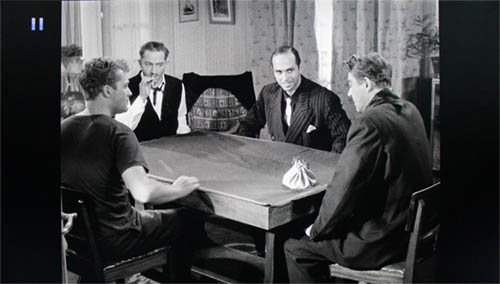
The biggest dent in the Toshiba 47VL863B’s performance is, as we expected, its greyish black level. During the night scenes of Taxi Driver, for example, we had to strain to remind ourselves of the blackness intended by the filmmakers, and to ignore the brighter patches of light which appeared around the corners of the screen (an almost standard issue with LED edge-lit LCD displays). In fact, even although it resulted in a less accurate picture with lessened shadow detailing, we did find ourselves reaching to enable the [LED Backlight Control] to do battle against the LCD panel’s low contrast performance, since contrast is a critical determining factor when it comes to picture quality – ahead of any sort of Gamma accuracy or shadow detail visibility. In any case, with the Toshiba 47VL863B, the choice is with the user.
Console Gaming
When we fired up our usual test game, Halo: Reach, we were happy to find that the Toshiba 47VL863B gave us a responsive, enjoyable experience in the “Game” mode, which measured just 16ms! This is a remarkably low figure for such a large LCD display. There’s a minor annoyance, though: Toshiba have enforced edge enhancement in the “Game” picture mode, and lowering the [Sharpness] control only blurs the overall enhanced image, rather than removing the sharpening. Because current generation games consoles don’t always do a very good job of producing anti-aliased graphics (in other words, their graphics often feature jagged edges), video games are the last place we’d want to see undefeatable edge enhancement! Fortunately, we weren’t too bothered by this, although it’s another case where more control would be welcome.
Conclusion
The Toshiba 47VL863B is a competitively priced 3D HDTV, the most unique selling point of which is its implementation of the passive 3D system, which has many advantages (and unfortunately, the one large disadvantage of lessened resolution) when compared to the more common active 3D method. What stops us from more heartily recommending it is its weak contrast performance. Blacks on the Toshiba 47VL863B never appear truly deep, instead having a greyness which we’re not used to seeing on modern displays. For this reason, we especially don’t recommend that users who are into watching films at night (or in similarly darkened rooms) consider the Toshiba 47VL863B.
However, at around £900 for the 47″ version, we think it will be a tempting proposition for prospective buyers looking for a 3D-capable HDTV in a brighter environment, where its grey-ish black level won’t be as much of a hindrance, and where the lack of flicker afforded by the passive 3D system will be a tremendous benefit. If you’re happy to accept contrast performance which isn’t class-leading, and the idea of black lines visible over the passive 3D images doesn’t bother you, then we encourage you to check out the Toshiba 47VL863B.



A question:
How exactly do you test for input lag vs crt monitor in your reviews?
Keep up the good work with your reviews they are the best out there, IMO.
Thank you for yet another detailed review. But you did not say the most important :)
How does the passive 3D of Toshiba compare to the Cinema 3D from LG ???
which is better and why ?
Again a passive 3D TV with greyish blacks. :-(
Is there any passive 3D TV with good black level on the market ?
(LCD or Plasma)
Till the Samsung RealD fullHD passive tvs coming out…
Hi, great review. Thinking of buying one.
I have a question though.. i recently returned a LG lw570s because it had horrible input lag while gaming in 3d mode (before a firmware update 2D mode also had horrible input lag btw, but that lag was much less after firmware update to 4.00.18).
Anyway, my question is, did you only test the 2D input lag on the Toshiba or also the 3D input lag? Because if you only tested 2D it could be that the Toshiba has the same problem as the LG in 3D mode, and i don’t think they’ll let me return another tv. ;-)
Thanks!
Situation clouding for this panel?
Tnx…
Thanks for another excellent review!
As you are putting so much effort on the calibration section, I’d really appreciate if you would include the final calibration settings in the reviews (either here or in FB page). Could you post the settings for this set somewhere, please. Thanks!